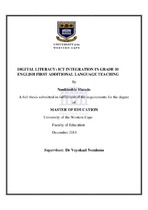| dc.contributor.advisor | Nomlomo, Vuyokazi | |
| dc.contributor.author | Shandu, Nonhlanhla | |
| dc.date.accessioned | 2014-10-16T08:53:14Z | |
| dc.date.available | 2014-10-16T08:53:14Z | |
| dc.date.issued | 2011 | |
| dc.identifier.uri | http://hdl.handle.net/11394/3782 | |
| dc.description | Magister Educationis - MEd | en_US |
| dc.description.abstract | The use of Information and Communication Technology (ICT) both in the General Education and Training (GET) and Further Education and Training (FET) bands is viewed as an innovative tool in enhancing a learner-centered approach to teaching and learning. As a result, a number of schools in rural and urban environments in South Africa have been provided with computers and other digital resources to facilitate teaching and learning. This study investigated the use of ICT in the teaching and learning of English First Additional Language (FAL) at Grade 10 level. It set out to discover digital resources and literacies to which teachers and learners were exposed in the English (FAL) classroom, and how these resources were used to enhance learners’ reading and writing skills. Following a qualitative research design, this study made use of classroom observations and interviews to collect data from teachers and Grade 10 learners. The collected evidence was from a single school which uses Khanya Project ICT materials. The school is located in one of the disadvantaged black townships in Cape Town. The study made use of Second Language Acquisition (SLA) theory and the constructivist theoretical framework to make sense of classroom interaction and the extent to which ICT and other teaching strategies were used to facilitate acquisition of English language skills, particularly reading and writing. The findings of the study show that there are a number of factors influencing ICT integration in Grade 10 English (FAL). These factors include teachers’ and learners’ limited access to ICT and digital literacy. Other factors relate to pedagogy and support in the use of ICT in teaching and learning. All the identified factors indicate that there are a number of barriers to ICT integration in English teaching and learning. The study concludes that ICT use has great potential in providing creativity and innovativeness to facilitate language teaching and learning. Given the lack of adequate ICT resources and under-utilization of ICT resources in disadvantaged schools, there is a need to improve teacher and learner access to ICT, especially in disadvantaged schools. This could be done through monitored support and adequate teacher training and active involvement of higher education institutions through teacher training programmes which should prioritize ICT integration in their curricula. | en_US |
| dc.language.iso | en | en_US |
| dc.subject | Digital Literacy | en_US |
| dc.subject | Information and Communication Technology (ICT) | en_US |
| dc.subject | English | en_US |
| dc.subject | Integration | en_US |
| dc.subject | Additional Language | en_US |
| dc.subject | Teaching | en_US |
| dc.subject | Literacy | en_US |
| dc.subject | Computer Assisted Language Learning (CALL) | en_US |
| dc.subject | e-Education | en_US |
| dc.subject | Further Education and Training | en_US |
| dc.subject | Second language acquisition | en_US |
| dc.title | Digital literacy: ICT intergration in grade 10 english first additional language teaching | en_US |
| dc.rights.holder | uwc | en_US |

